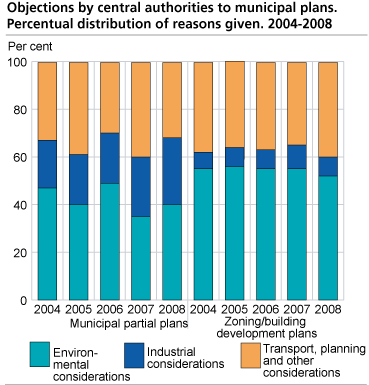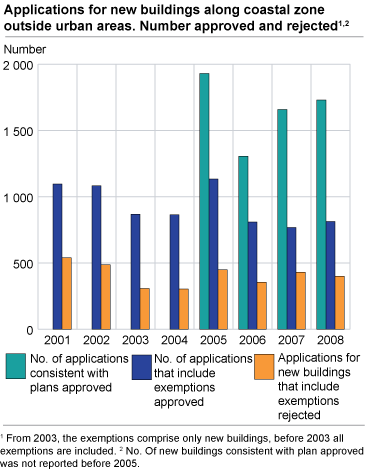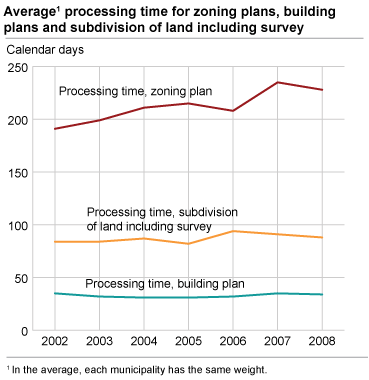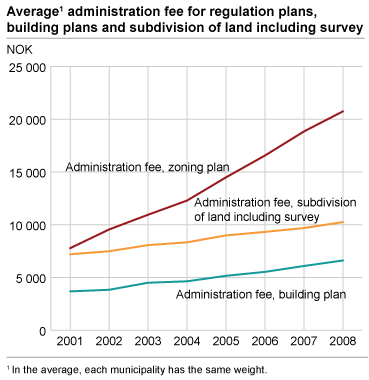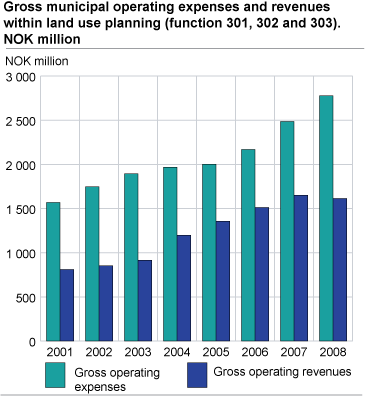Content
Published:
This is an archived release.
More dispensations granted in the shore zone
The number of applications for exemptions for new buildings in the shore zone was about the same in 2008 as the year before. However, the number of dispensations granted showed an increase after several years with a downward trend.
The total number of dispensations granted was 812 1 , compared with 767 in 2007. The share of applications granted that include exemptions rose from 64 to 67 per cent.
The general ban on building developments in the shore zone does not apply in urban areas or areas regulated for development. Therefore, the number of exemptions does not give a full picture of the level of development in the shore zone. In 2008, approximately 1 730 applications for new buildings in the coastal zone were granted in accordance with municipal plans. This is about the same level as the previous year.
Increase in objections to detailed plans
Norwegian municipalities have a vital impact on the protection and management of the environment through the administration of the Planning and Building Act. To safeguard national interests, other public authorities may object to municipal plans if they are in conflict with national or other vital interests.
Public authorities objected to 47 per cent of all municipal plans and 28 per cent of the detailed plans circulated for consultation in 2008. Compared with 2007 figures, this is a decrease in objections to municipal plans, but an increase in objections to detailed plans. More than 50 per cent of the objections were due to environmental considerations (see figure 2).
KOSTRA does not contain information on the results of these objections. The municipalities may either comply; negotiate with the objecting authority, or a final decision is taken in the Ministry of the Environment.
Expenses in land use planning increases
In 2008, gross expenses for land use planning amounted to NOK 2.78 billion. The municipalities’ gross income covered NOK 1.61 billion of these expenses. From 2007, gross expenses rose by 12 per cent, while the income went down by 2 per cent. This is the first year with a decrease in income since the reporting started in 2001. However, administration fees continue to increase. The average fees for development plans, building plans and subdivision of land including survey increased last year by 10, 9 and 6 per cent 2 respectively.
The processing time for zoning plans, building projects and subdivision of land was 228, 34 and 88 calendar days respectively. This is a decrease in processing time for all the categories. However, these figures are uncertain.
For general information on KOSTRA, see http://www.ssb.no/english/subjects/00/00/20/kostra_en/ .
See also:
Development in the shore zone , and Local environmental efforts in municipalities and county authorities.
1 Approximately 85 per cent of the municipalities have reported, and the figure is estimated on the basis of these.
2 This is the average increase in reporting municipalities, where each municipality has the same weight. Total administration fees are however also dependent on the size of the municipality.
Tables:
- Table 1 Building project applications in areas of particular environmental value
- Table 2 Average processing time and administration fee for regulation plans, building plans and subdivision of land including survey. By inhabitants in the municipality
- Table 3 Case load of regulation plans, building plans and subdivision of land including survey. Weighted average
- Table 4 Share of municipalities with plan for biological diversity, outdoor recreation and preservation of cultural heritage, universal design and climate/energy. Average age of plans in the year of reporting
- Table 5 Municipal expenses, revenues and investments within land use planning (function 301, 302 og 303)
- Table 6 Applications for exemptions relating to the cultural heritage act and the planning and building act
- Table 7 Number of county authorities with existing plan for different topics. Average age of the plans in the year of reporting
- Table 8 Gross operating expenses, operating revenues and investments in local and regional development - area and nature (function 715). County authorities. NOK 1 000
Find more figures
Find detailed figures from Town and country planning in municipalities and county authorities
Contact
-
Ingeborg Hauge
E-mail: ingeborg.hauge@ssb.no
tel.: (+47) 95 87 66 56
-
Jørn Kristian Undelstvedt
E-mail: jorn.kristian.undelstvedt@ssb.no
tel.: (+47) 94 50 68 64

